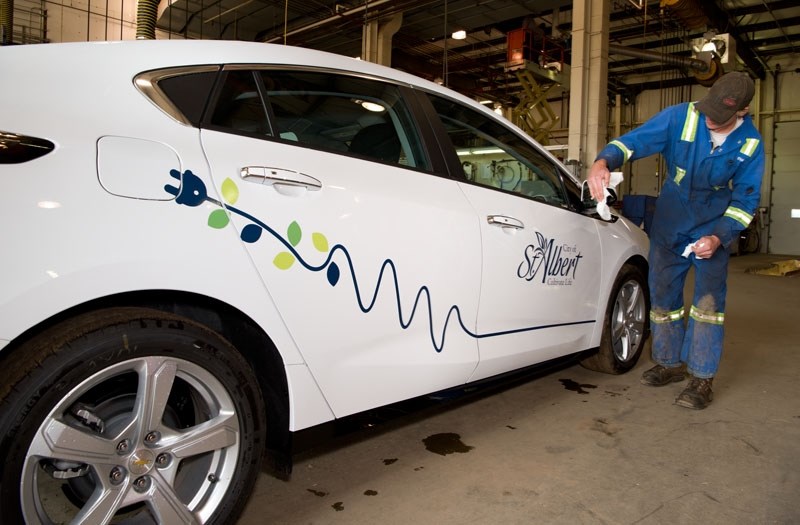City staffers have added two electric cars to their fleet – a pricey move that will prevent about five tonnes of emissions per year.
Two new 2016 Chevy Volts rolled into the Jack Kraft Facility this week. The plug-in hybrid cars are the first electric vehicles in the city’s corporate fleet.
The new cars are meant to replace two old Chevy Cobalts and will be used for mail delivery and by the fire department, said Chris Richards, the city’s asset management manager. The city got them as part of its ongoing efforts to reduce greenhouse gas emissions.
These are apparently the first 2016 Volts to be sold in Western Canada, said Mark Mitchell, fleet maintenance planner with the city, who took the Gazette for a test-drive in one. They’re pricey, at about $37,000 apiece, but ultra efficient – the in-car meter suggests it uses the equivalent of 0.7 litres per 100 kilometres.
The car has a dedicated electric motor that runs for about 84 km on a charge, Mitchell said. Once that’s gone, it switches to a gasoline engine with about 600 km of range. Since the city’s mail drivers drive just 70 km a day, they should realistically never have to use the gas engine.
“That’s a lot better for the environment.”
These cars will have zero tailpipe emissions as they’ll be running on electricity, Richards said. Since it has a gas engine backup, there’s also no worry about running out of charge in the field.
Richards said he expected these vehicles would cost about 40 per cent less to run per year than conventional ones, based on information from the 2015 Electrifying Vehicles study by Simon Fraser University.
Natural Resources Canada reports that a 2016 Chevy Volt should get the equivalent of 2.2 L/100 km on battery and 5.6 on gas compared to 6.8 for a 2016 Cruze (the modern equivalent to the Cobalt). After 20,000 km, the Volt will have produced about 80 per cent fewer greenhouse gas emissions (or 2.54 tonnes less) than the Cruze.
“As the grid becomes cleaner, the car becomes even more of a good decision,” Richards said.
The Volt costs $653 a year to run compared to $1,482 for the Cruze, NRCAN reports. Given that a basic Volt costs about $18,195 more than a basic automatic Cruze (according to chevrolet.ca), it will be about 22 years before the city makes that extra cost back through operating savings (assuming fuel prices never change).
“If you just use straight across the board economics, it’s not a strong case,” Richards said.
The city made this move to show environmental leadership, reduce greenhouse gas emissions, and test how electric vehicles perform in St. Albert, he explained.
“We’re not doing this for money.”
Crews will monitor these cars’ performance closely over the next few years, Richards said. While they do plan to bring in more electric vehicles, they’ve got few options right now: most of their vehicles are trucks, and there aren’t many electric trucks available.
The city also bought three electric buses earlier this year. Scheduled to arrive this fall, these vehicles produce about 51 per cent fewer emissions than conventional ones and (due to GreenTRIP funding) will pay for themselves in fuel savings in about nine years.
City residents can hear a free talk next week on how home renovations can save them money.
The Solar Energy Society of Alberta is hosting a free talk Wednesday on deep energy retrofits.
About 80 per cent of the homes that will be around in 2050 exist today, said Rob Harlan, the society’s executive director.
“We have a tremendous retrofit challenge ahead of us, because energy costs will be tremendous at that point.”
Former St. Albert resident Stuart Fix will speak about how he did such a retrofit to his 1943 home in Edmonton.
“We basically did a complete overhaul,” he said, ripping out walls, replacing windows and furnaces, and adding massive amounts of insulation. The roof now has about 12 times more heat-trapping capability, which should significantly reduce the home’s heating needs.
While it could take about 50 years for him to make his money back in energy savings, Fix said he didn’t do his renovation for money.
“It’s a health and comfort thing for us.”
The talk runs from 7 to 8:30 p.m. at MacEwan University’s CN Theatre this May 18. Visit solaralberta.ca for details.




